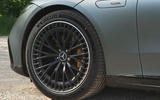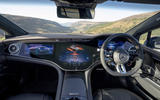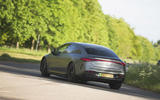With no sizeable transmission to house and therefore more space to play with, Mercedes had the opportunity to make the interior of the Mercedes EQS feel even more lounge-like and lavishly breezy than that of the Mercedes S-Class. Clearly, specification matters, and our test car’s dark upholstery and the looming presence of the misnamed Hyperscreen (actually three separate OLED screens, and standard-fit on our Night Edition test car but otherwise a £7995 option) didn’t help the cause, but our testers found this cabin an unenchanting environment.
Key complaints related to questionable perceived quality and the ever-so-slightly claustrophobic atmosphere created by the high beltline and scuttle. There’s too much flex in certain panels when they’re pushed or leant on, the odd creak and occasionally misaligned stitching.
There are some lovely elements in here (the way the door cards flow into the dashboard and the manner in which the centre console branches outwards as it meets the Hyperscreen), but they’re undermined by a pervasive sense of chintz and the unimaginative layout.
The AMG-specific sports seats of our 53 test car, with their smartly integrated headrest, were also found wanting in terms of support and were felt to look just a little ordinary, given the car’s circa-£160,000 asking price.
As for AMG-specific elements, they’re spread thinly. The steering wheel is clad partly in Alcantara and there are the seats and AMG-branded floor mats, plus some graphic cues within the technological array. It’s subtle, but then again it would be, the number 53 historically denoting a milder flavour of Affalterbachness than 63, which might yet make an appearance in the EQS line-up.
Rear passengers have a similarly mixed experience. Leg room is superb – truly worthy of the term limousine. There’s also generous head room, and at night the ambient lighting that gives the front of the cabin such an inspiring lift works its magic in the back, too. However, the regular seats are short of squab and slightly too upright.
The Luxury Lounge pack, with its individually adjustable seats, would improve things but is available only on the Touring version of the EQS 53.
Multimedia system
 The MBUX infotainment system in the EQS pairs very neatly and wirelessly with both Apple CarPlay and Android Auto. Equally, the OLED displays – that is, the 18.0in central display, the 12.0in passenger display and the familiar digital instrument binnacle – are all beautifully crisp to behold and only rarely showed any latency issues during our test.
The MBUX infotainment system in the EQS pairs very neatly and wirelessly with both Apple CarPlay and Android Auto. Equally, the OLED displays – that is, the 18.0in central display, the 12.0in passenger display and the familiar digital instrument binnacle – are all beautifully crisp to behold and only rarely showed any latency issues during our test.
However, despite the useful shortcuts lined up just ahead of the central armrest, you might rue the lack of physical switchgear, particularly for the audio volume, which can be tricky to adjust. There’s also a chance that you might find the optional Hyperscreen display – costing £7995 but fitted to AMG models as standard – just a touch overwhelming in general, particularly at night. Consider yourself warned.
Otherwise, the level of functionality is deeply impressive. The sat-nav automatically shows charging stations, their speed and their availability and factors in a stop if necessary, accounting for the topography and speed of the journey. (As an aside, we found the range estimator unusually accurate).













































 The MBUX infotainment system in the EQS pairs very neatly and wirelessly with both Apple CarPlay and Android Auto. Equally, the OLED displays – that is, the 18.0in central display, the 12.0in passenger display and the familiar digital instrument binnacle – are all beautifully crisp to behold and only rarely showed any latency issues during our test.
The MBUX infotainment system in the EQS pairs very neatly and wirelessly with both Apple CarPlay and Android Auto. Equally, the OLED displays – that is, the 18.0in central display, the 12.0in passenger display and the familiar digital instrument binnacle – are all beautifully crisp to behold and only rarely showed any latency issues during our test.









